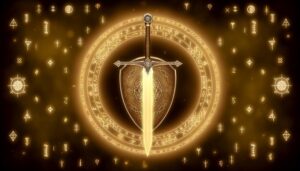What Is the Meaning of the Snake Eating Its Tail Symbol?
The ouroboros, depicted as a snake or serpent eating its own tail, signifies the eternal cycle of life, death, and rebirth. Originating in Ancient Egyptian iconography, it illustrates the universe's cyclical nature and perpetual renewal.
Greek and Roman interpretations expanded its meaning to encompass transformation and the unity of opposites, influencing philosophies and alchemical practices. Emblematic of cosmic balance and introspection, the ouroboros also features prominently in alchemical texts and literature, symbolizing unending continuity and spiritual growth.
Understanding this symbol provides profound insights into its enduring relevance across historical and philosophical contexts. Learn more about its multifaceted significance.
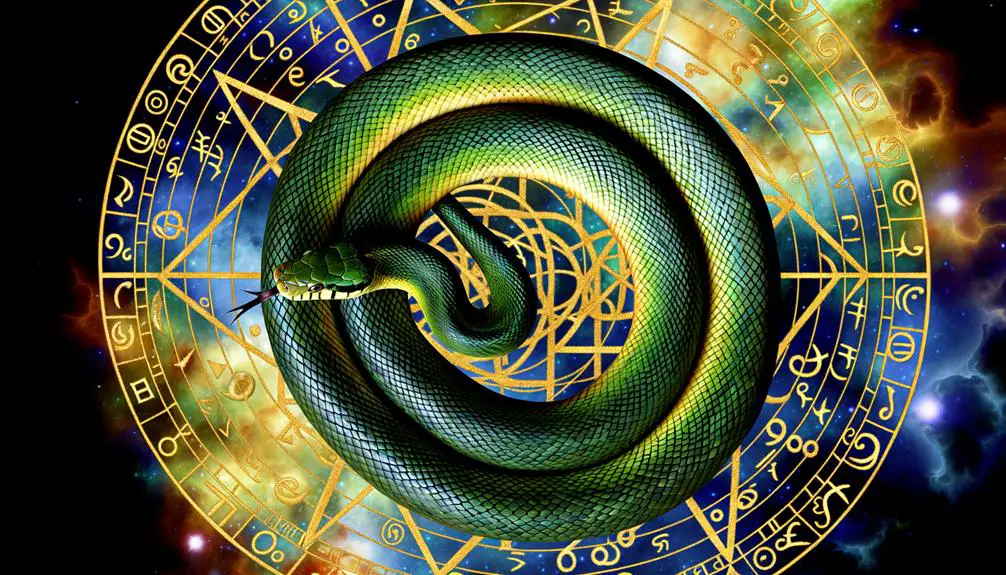
Key Takeaways
- The ouroboros symbolizes the cyclical nature of the universe and eternal renewal.
- It represents the eternal cycle of life, death, and rebirth in Greek and Roman interpretations.
- In alchemy, the ouroboros symbolizes transmutation and the balance between creation and dissolution.
- The symbol reflects perpetual transformation and unity of opposites in philosophical contexts.
- It serves as a reminder of the interconnected nature of all existence and spiritual growth.
Ancient Egyptian Origins
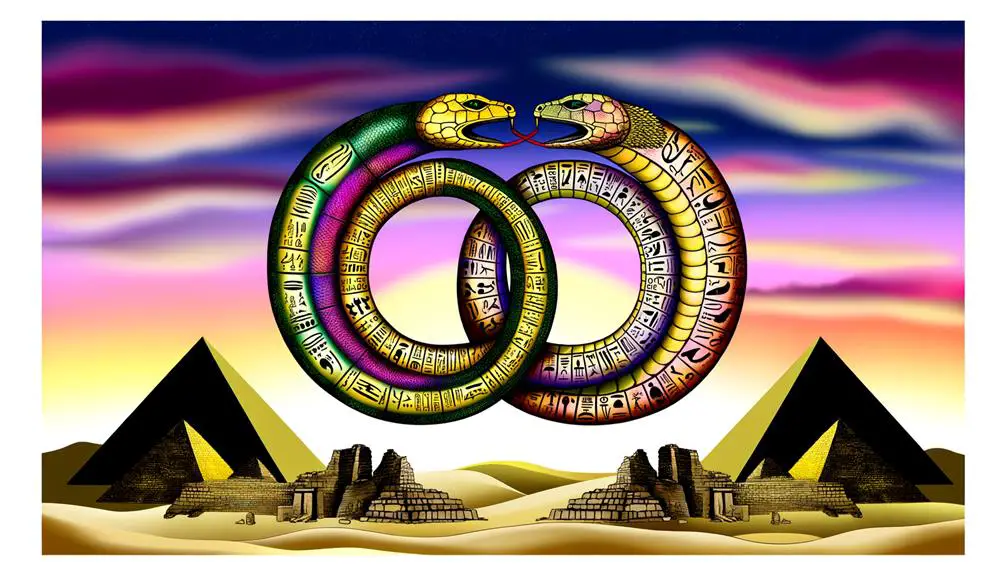
The symbol of a snake eating its own tail, known as the ouroboros, finds its origins in ancient Egyptian iconography, where it represented the cyclical nature of the universe and the concept of eternal renewal. This emblem first appeared in the tomb of Tutankhamun, signifying the infinite loop of life and death, and the perpetual return to a primordial state.
The Egyptians saw the ouroboros as a powerful metaphor for the unity of all things, encapsulating the idea that beginnings and endings are intrinsically connected. It symbolized the ongoing process of creation and destruction, illustrating their profound understanding of life's interwoven and repeating patterns. Therefore, the ouroboros became a potent emblem of cosmic balance and perpetual transformation.
Greek and Roman Interpretations
In Greek and Roman traditions, the Ouroboros symbolizes the eternal cycle of life, death, and rebirth, often appearing in mythology as a representation of the universe's cyclical nature.
Philosophically, it serves as a profound emblem of self-reflection and introspection, resonating with the Stoic and Neoplatonic schools of thought.
Additionally, its influence extends to alchemical practices, where it epitomizes transformation and the unity of opposites.
Ouroboros in Mythology
Greek and Roman mythology extensively features the Ouroboros, symbolizing the eternal cycle of life, death, and rebirth, reflective of their cosmological and philosophical beliefs. The enduring image of the serpent consuming its own tail is emblematic of the cyclical nature of existence and the universe's perpetual state of renewal. Within these ancient traditions, the Ouroboros often appeared in alchemical texts and religious iconography, linking it to the concept of infinity and the unity of all things. Here is a comparison of Greek and Roman perspectives:
| Aspect | Greek Interpretation | Roman Interpretation |
|---|---|---|
| Symbolism | Cosmic Cycles | Eternal Continuity |
| Deities | Gaia, Chronos | Saturn, Terra |
| Alchemy | Early Proto-Alchemical Texts | Integration in Later Alchemy |
| Art | Vase Paintings, Mosaics | Frescoes, Statues |
| Influence | Philosophers like Plato | Stoic Thinkers like Seneca |
Greek and Roman mythologies profoundly embedded the Ouroboros in their cultural fabric, exemplifying their understanding of eternal recurrence.
Philosophical Symbolism Insights
Building on the mythological grounding, the philosophical symbolism of the Ouroboros in Greek and Roman contexts reveals deep insights into their respective worldviews and existential inquiries. This ancient symbol is not merely an artistic motif but a profound representation of cyclical time, unity, and the perpetual nature of existence.
Key insights include:
- Cyclical Time: Reflects the Greeks' belief in eternal recurrence and the Romans' concept of cyclical history.
- Unity of Opposites: Embodies Heraclitus' philosophy that opposites coexist in harmony.
- Self-sufficiency: Signifies Stoic ideals of self-contained existence and autonomy.
- Transformation: Illustrates the perpetual process of change and rebirth, resonating with Platonic and Aristotelian thought.
These interpretations underscore the Ouroboros as a lens through which timeless philosophical questions are explored.
Influence on Alchemy
The Ouroboros profoundly influenced alchemical traditions by symbolizing the interconnected processes of creation and dissolution central to both Greek and Roman interpretations.
In alchemy, this emblematic serpent encapsulated the cyclical nature of transmutation, representing the perpetual renewal of matter.
Greek alchemists perceived the Ouroboros as an illustration of the cosmos' unity, emphasizing the balance between opposing forces.
Roman interpretations further aligned with this view, underscoring the eternal cycle of life, death, and rebirth.
This symbol often adorned alchemical texts, serving as a visual reminder of the alchemist's quest for the Philosopher's Stone—a metaphor for achieving spiritual and material perfection.
Therefore, the Ouroboros became a cornerstone of alchemical thought, bridging philosophical and practical pursuits in ancient traditions.
Norse and Celtic Views
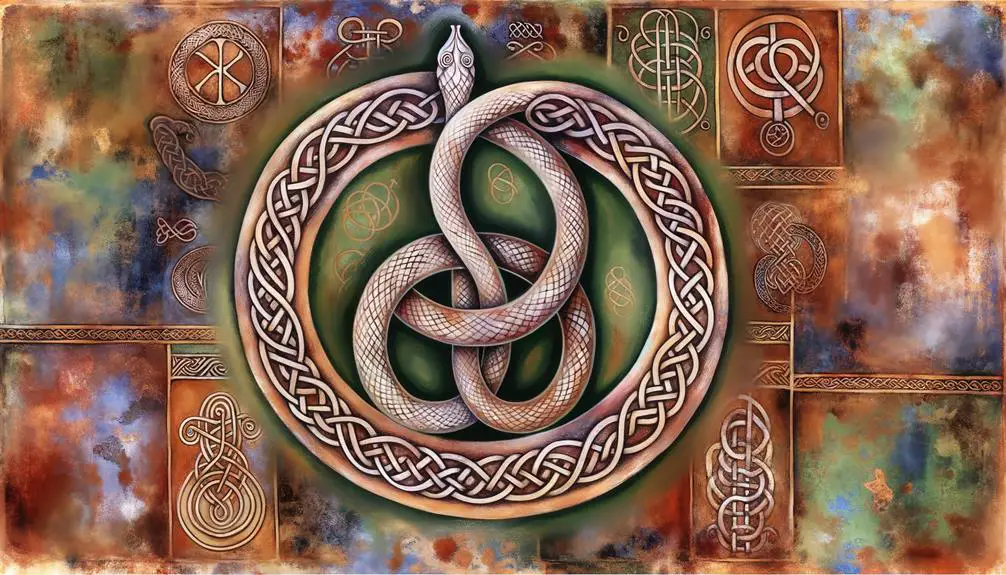
In both Norse and Celtic traditions, the symbol of a snake eating its tail—known as the Ouroboros—serves as a profound representation of cyclical time and the perpetual nature of life and existence. This emblem is imbued with multifaceted layers of meaning, reflecting the cultural ethos of these ancient societies.
Norse Mythology:
The Midgard Serpent, Jörmungandr, encircles the world, embodying the endless cycle of time.
Celtic Beliefs:
The Ouroboros represents the interconnectedness of life, death, and rebirth.
Eternal Cycle:
Both traditions link the symbol to the concept of eternal return and renewal.
Symbolic Continuity:
It signifies the unbroken chain of existence, reinforcing themes of unity and perpetual motion.
This intricate symbol thereby encapsulates fundamental philosophical notions in both Norse and Celtic cultures.
Symbolism in Alchemy
Emerging as a pivotal symbol within the esoteric tradition of alchemy, the Ouroboros encapsulates the principle of unity and the transformative cycle of creation and destruction.
This ancient emblem, depicting a serpent consuming its own tail, serves as a profound metaphor for the alchemical opus—the process through which base materials are transmuted into the philosopher's stone. It signifies the eternal return and the cyclical nature of all processes, emphasizing the interconnectedness of beginnings and endings.
In alchemical texts, the Ouroboros often appears as a representation of the prima materia, the original substance from which all matter is formed. This symbolism underscores the alchemists' quest for spiritual and material perfection, illustrating the perpetual evolution inherent in their mystical practice.
Psychological Perspectives
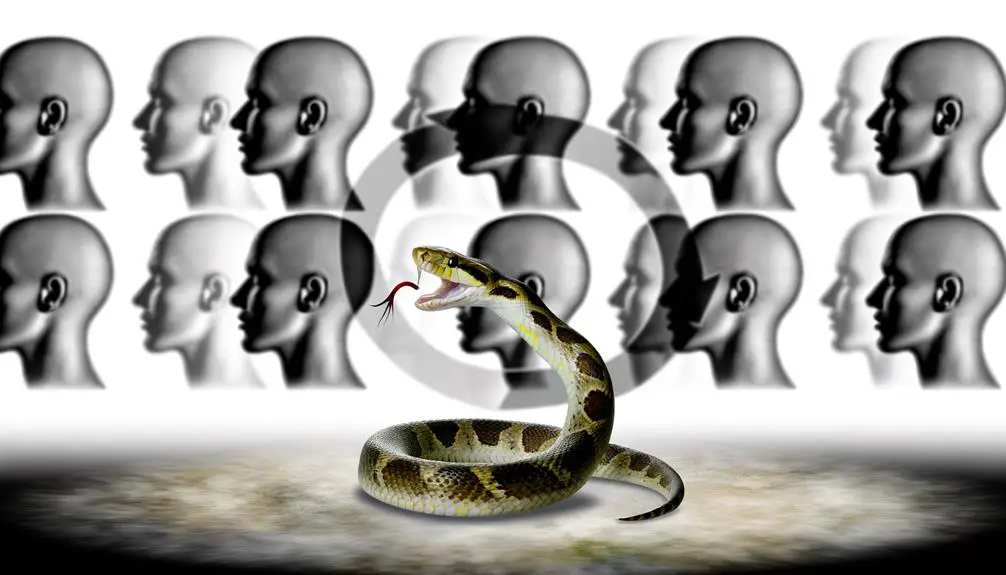
Beyond its alchemical roots, the Ouroboros also holds significant psychological implications, particularly in relation to Carl Jung's theories on the collective unconscious and the integration of the self.
Jung viewed the Ouroboros as a symbol of the psyche's drive towards wholeness and individuation. This ancient symbol encapsulates the cyclical nature of psychological processes and personal transformation.
- Self-Reflection: The Ouroboros prompts introspection and recognition of one's inner cycles.
- Transformation: It symbolizes the ongoing process of self-renewal and growth.
- Balancing Opposites: The image reflects the integration of conscious and unconscious elements.
- Wholeness: It represents the ultimate goal of achieving psychological completeness.
Modern Cultural Impact
The Ouroboros, as a symbol, continues to resonate deeply in modern culture, reflecting themes of rebirth, continuity, and the interconnectedness of life and death.
Its presence can be seen across various domains, from contemporary art and fashion to digital media and corporate branding. This ancient emblem is often adopted to signify perpetual renewal and the cyclical nature of processes, appealing to a society increasingly concerned with sustainability and holistic perspectives.
In the digital age, the Ouroboros also symbolizes the infinite loop of information and the relentless cycle of creation and consumption. Its enduring relevance underscores a collective yearning for meaning and coherence in an ever-evolving world, bridging past wisdom with present-day aspirations.
Symbol in Literature
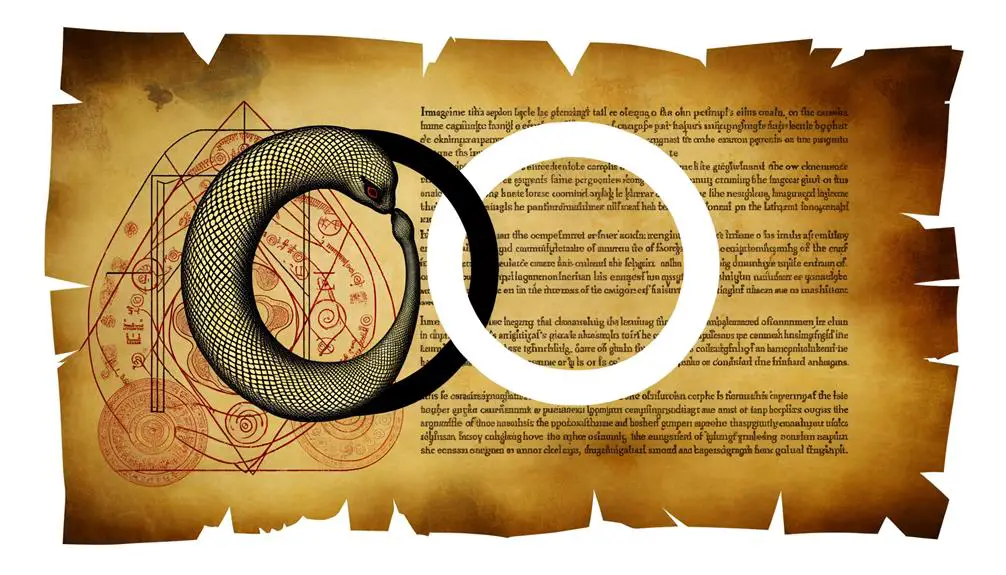
The symbol of the snake eating its tail, known as the Ouroboros, frequently appears in literature to underscore the cyclical nature of stories and the concept of eternal life.
This ancient motif serves as a powerful narrative device, reflecting the unending cycle of beginnings and endings that permeate human existence.
Cyclical Nature of Stories
Exploring the symbol of the snake eating its tail, known as the ouroboros, reveals its profound representation of the cyclical nature of stories in literature. This ancient emblem encapsulates narratives that continually return to their origins, highlighting the perpetual ebb and flow of human experience.
The ouroboros embodies several key aspects of storytelling:
- Rebirth and Renewal: Characters and themes often undergo cycles of transformation and return.
- Timelessness: Stories transcend temporal boundaries, reflecting universal truths.
- Interconnectedness: Plotlines and character arcs interweave, creating a seamless narrative loop.
- Resonance: Recurring motifs enhance thematic depth and reader engagement.
Analyzing the ouroboros in literature underscores the inherent circularity that defines many of the world's most enduring tales, enriching our comprehension of narrative structure.
Eternal Life Themes
Drawing from the cyclical nature of stories embodied by the ouroboros, the symbol also profoundly encapsulates themes of eternal life in literature. This ancient emblem represents the perpetual renewal and unending continuity of existence.
In literary contexts, the ouroboros often appears in narratives exploring resurrection, immortality, and the cyclical nature of time. Authors utilize this symbol to convey the idea that life, death, and rebirth are interconnected, suggesting that endings are merely preludes to new beginnings.
For instance, in myths and fantasy genres, characters might encounter the ouroboros as a sign of their eternal journey or transformation. By integrating the ouroboros, literature not only reflects on the constancy of life but also invites readers to contemplate the infinite loop of existence.
Personal and Spiritual Significance
Understanding the personal and spiritual significance of the snake eating its tail, known as the ouroboros, requires delving into its profound symbolism of cyclical renewal and the interconnectedness of life and death. This ancient emblem resonates deeply with individuals seeking meaning in their spiritual journey. The ouroboros can serve as a contemplative focus, reminding one to embrace the perpetual cycle of transformation.
Its significance encompasses:
- Self-Reflection: Encourages introspection about one's own life cycles.
- Resilience: Symbolizes the ability to regenerate and overcome challenges.
- Unity: Represents the interconnected nature of all existence.
- Spiritual Growth: Inspires continuous personal and spiritual development.
Conclusion
The symbol of the snake eating its tail, known as the ouroboros, has traversed the annals of history, embodying a myriad of interpretations from ancient Egyptian cosmology to modern psychological theories.
Each cultural and temporal context has imbued this emblem with profound significance, rendering it an almost omnipotent symbol of eternity, unity, and cyclicality.
Its enduring presence in alchemy, literature, and personal spirituality underscores its unparalleled capacity to encapsulate the infinite complexities of existence.



